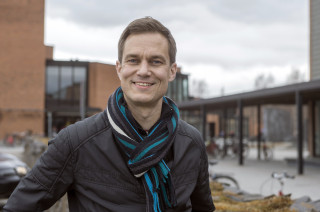Finns are in favour of increasing the use of wind power. Yet, very few would like to see a wind power station near their summer house. Does the NIMBY phenomenon pose a threat to ecological reconstruction that seeks to abolish large-scale use of fossil fuels?
- Text Sari Eskelinen | Illustration Mostphotos, Raija Törrönen, Varpu Heiskanen and CORE project
Would you like to see an increase in the use of renewable energy? Meat-free days at schools? Are you ready to take concrete steps in your everyday life so that Finland, and countries around the globe, can reach their climate policy goals? According to the Finnish Innovation Fund Sitra’s recent Resource-wise Citizen Survey, the majority of Finns consider sustainable lifestyle choices to be important. More than half of them have also reduced their consumption for environmental reasons, and they think about the environmental impact of their travel.
Despite these numbers, the construction of a wind power plant to produce sustainable energy can give rise to local opposition of wind power. This is known as the Not In My Back Yard phenomenon, or Nimby for short. Put in simple terms, it refers to opposing a public good for the sake of private gain.
“In opinion polls, most Finns consider wind power to be a good thing. This is part of the reason why there was little attention on the acceptability and challenges of wind power construction in the early days of the wind power boom,” Professor of Environmental Conflict Resolution Lasse Peltonen says.
In opinion polls, most Finns consider wind power to be a good thing.
Is the transition fair to everyone?
The Finnish Innovation Fund Sitra has identified ecological reconstruction one of the mega trends of the 2020s. Ecological reconstruction refers to the reconstruction of infrastructures of living, transportation, food and energy production for the sake of moving beyond the fossil economy. Ecological reconstruction also causes tensions, with one example being the question of whether the sustainability transition is fair to everyone.
According to Professor Peltonen, decision-makers and companies and stakeholders operating in the energy sector have internalised the necessity of wind power construction.
“While policy makers and markets largely accept wind power, the third pillar of social acceptance resides with local communities. This pillar is one of the key challenges of wind power, yet it seems that are gaps in understanding the local realities and in devising ways to address them constructively.”
Different stakeholders should work together to find solutions to how wind power projects can be implemented and how to bridge possible gaps between external constructors and local residents, for example.
“A top-down approach won’t work,” Professor Peltonen notes.

Not just facts, but real influence
Atte Saastamoinen wrote his Master’s thesis at the University of Eastern Finland, and he found that people’s attitudes towards the landscape effects of wind power, in particular, were mostly negative. Summer house owners felt that they were being threatened on their own property, making wind power projects seem increasingly unjust.
Giving local communities partial ownership in wind power projects has been used as one possibility to win them over, and this would also generate resources for local development, among other things. Professor Peltonen says that the effects of wind power projects can also be monitored in collaboration with local stakeholders, making the activities increasingly transparent and easier to understand.
“Whether the local community feels that it has some control over its destiny, or whether it feels like it is being overwhelmed with things its struggles to understand, plays a key role. In the latter case, resistance may well seem like the only option.”
Professor Peltonen says that people aren’t as rational as generally thought, and mere facts aren’t enough to change attitudes or behaviour.
“Social and emotional factors are crucial. Emotions are part of social acceptance.”
It is important to identify stakeholders who play a key role in solving the problem.
Lasse Peltonen
Professor of Environmental Conflict Resolution

Bringing key stakeholders around the same table
Various solutions to foster dialogue between local stakeholders have been developed in the US. For instance, the American Wind and Wildlife Institute, a joint effort by wind energy developers and nature conservationists, looks for ways to incorporate the interests of wind power and nature conservation.
The CORE project, on the other hand, explores novel forms of collaboration for natural resources governance. One of the project’s case studies focuses on a new procedure that was tested in the preparation of a forest programme for the City of Jyväskylä in Finland. Various stakeholders sat around the same table to plan how the city’s forests could serve different needs relating to the economy, environmental conservation, and recreation. Another case study in the CORE project examines the relations and collaboration of the Finnish Sodankylä municipality and its stakeholders with mining companies operating in the area.
Professor Peltonen points out that civic participation is an important component in collaborative governance. However, the idea is not to involve everyone in every step of the process.
“Collaboration works best through group processes with organised interests represented. It is important to identify stakeholders who play a key role in solving the problem. This may include opponents who think very differently from one another. Thus, conflict resolution is always an aspect of collaboration.”

Social acceptance should be seen as an ongoing process where varying degrees and ways of participation are needed. Public information campaigns around projects reach large numbers of local people affected by them. However, information campaigns and standard public consultation procedures lack the elements of negotiation and collaboration, which are needed in more difficult processes and conflict situations. This means that the forms of collaboration will become more demanding and intensive, and the role of organised stakeholders gets emphasised.
“This calls for joint planning and commitment, and everyone should bring their own resources and skills to the table”
Social license to operate is critically important
In ten years’ time, almost 50% of Finns will be living in carbon neutral municipalities, if the municipalities are able to achieve their climate targets. Indeed, more than 70 Finnish municipalities have already committed to reducing their greenhouse gas emissions by 80% from the level of 2007 by 2030. These municipalities are home to nearly two million Finns.

Among the tools employed by the municipalities are increasing the use of renewable energy and enhancing energy efficiency. Local companies and residents, too, are encouraged to take climate action. All of this is just one component in the wider ecological reconstruction project. According to Professor Peltonen, social license to operate is a critical success factor for the project.
“If this isn’t understood in time, various conflicts can slow down or hinder ecological reconstruction, or we may even end up in a situation where conflicts escalate. The same conflicts can also fuel social polarisation. This is why it is important to highlight the theme of just transition, and this, too, calls for reconciling interests and resolving conflicts.”



